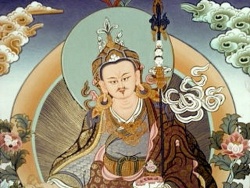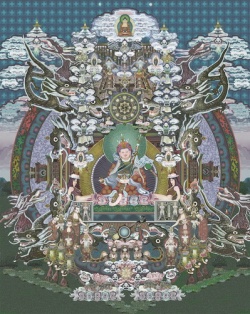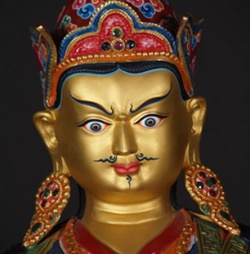Padmasambhava In Zahor
At ‘the Vajra seat’ in Bodhgaya, he displayed miracles, acknowledging he was a self-manifested buddha, and then he went to the land of Zahor.
Although Padmasambhava was a fully enlightened buddha, he appeared as a nirmanakaya manifestation to tame and teach beings in this age, and so for their benefit he acted as if receiving teachings,
accomplishing the practice and passing through the various stages of spiritual realization, one by one. Some accounts tell how in Vajrasana, he was ordained by the Buddha’s closest disciple, Ananda.
Others say he took ordination from Prabhahasti in Zahor, and was given the name Shakya Sengé, ‘Lion of the Shakyas’.
He received the teachings on Yoga Tantra from him eighteen times, and experienced pure visions of the deities.
Then he received empowerment from the wisdom dakini Kungamo, also known as Khandroma Lékyi Wangmo,
who transformed him into a syllable HUNG, swallowed him, and passed him through her body and out through her secret lotus, granting him outer, inner and secret empowerments, and purifying the three obscurations.
From the eight vidyadharas at Deché Tsekpa, he received the teachings on the eight great sadhanas of Kagyé, from Buddhaguhya the teachings on ‘The Secret Essence Tantra’, and from Shri Singha the teachings of Dzogpachenpo.
Padmasambhava would master a teaching the first time he encountered it, and experienced visions of deities without needing to practise.
Attaining the first vidyadhara level, the stage of ‘the vidyadhara level of maturation’ or ‘vidyadhara with karmic residue’, Guru Rinpoche was known as Loden Choksé, ‘Wise Seeker of the Sublime’.
Returning to Zahor, Padmasambhava took the royal princess Mandarava as his consort, and they then went to the Maratika cave, where for three months they practised the sadhana of longevity.
The Buddha of Limitless Life, Amitayus appeared, empowered them with longevity, and blessed them as inseparable from him.
They both accomplished the second vidyadhara level, ‘vidyadhara with mastery over life’.
The king of Zahor and his ministers arrested Guru Rinpoche and Mandarava and burned him alive, but he transformed the pyre into a lake, and was found sitting, cool and fresh, on a lotus blossom in its centre.
This lake is considered to be the Rewalsar Lake, ‘Tso Pema’, in the present-day Indian state of Himachal Pradesh.
Overcome with remorse, and in homage, the king offered Padmasambhava his entire kingdom, beginning with his garments and his five royal robes.
In paintings and statues, Guru Rinpoche is portrayed wearing the clothing of the king of Zahor.
For example, the hat offered by the king is called The Lotus which Liberates on Sight,
or The Petalled Hat of the Five Families; its inner and outer layers symbolize the unity of generation and completion phases, its three points the three kayas, its five colours the five kayas working for the benefit of beings,
the sun and moon skilful means and wisdom, its blue border unlimited samaya, the vajra top unshakeable concentration and the vulture’s feather the realization of the highest view and the culmination of the practice.
Guru Rinpoche taught the king and subjects of Zahor, and many attained realization.
With Mandarava, he then returned to Oddiyana, but was recognized, and burned on a sandalwood pyre.
After some time, they were found seated on a lotus in a lake of sesame oil, wearing a garland of skulls,
as a symbol of their liberating all beings from samsara through compassion. Padmasambhava was now known as Pema Thötreng Tsal, ‘The Powerful Lotus-born, with a Garland of Skulls’.
For thirteen years Padmasambhava and Mandarava remained to teach in Oddiyana, as a result of which the king, queen and many others attained realization and the rainbow body.
Then Padmasambhava was known as Padma Raja—Pema Gyalpo—, ‘The Lotus-born King’.
Manifesting himself as the monk Indrasena, it is said that Padmasambhava inspired the great king, Ashoka (3rd century BC), to have faith in the Buddhadharma.
After defeating various anti-Buddhist rulers, Guru Rinpoche was poisoned, but remained unharmed, and he was thrown in the Ganges, but made the river flow upstream and danced in the air,
therefore earning the name of Khyeu Khanding Tsal, ‘Mighty Youth, Soaring in the Sky like a Garuda’.
He manifested as a number of great siddhas, such as Saroruha, Saraha, Dombi Heruka, Virupa and Krishnacharya.
In charnel grounds like Kuladzokpa, ‘Perfected in Body’, he taught the secret mantra to dakinis, and made outer and inner spirits into protectors of the Dharma.
He was then known as Nyima Özer, ‘Rays of the Sun’.
Padmasambhava challenged and defeated five hundred upholders of wrong views in debate at Bodhgaya.
He reversed their magic with the aid of a wrathful mantra given him by the lion-faced dakini Marajita.
He was known as Senge Dradok, ‘The Lion’s Roar’.


